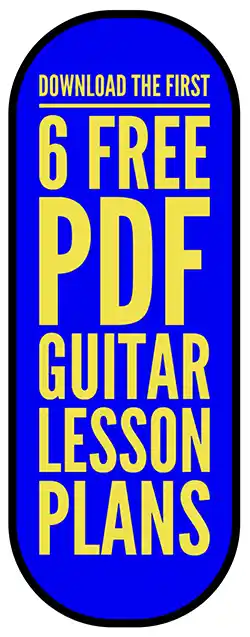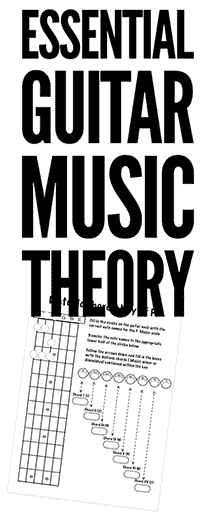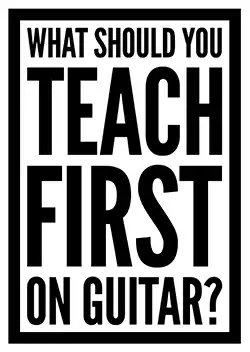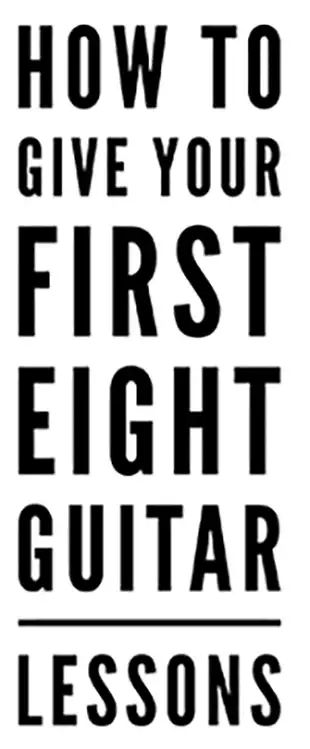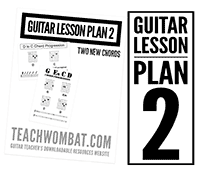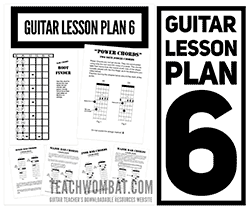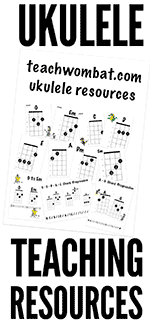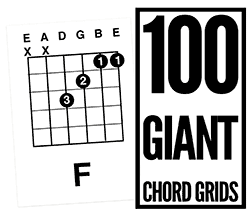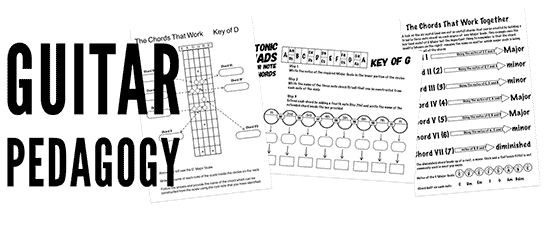
Theory, Technique and Repertoire are the three pillars upon which Guitar Pedagogy is built
There are a whole heap of resources that you can download from this page that look at developing a healthy and "joined up" pedagogical approach to teaching the guitar

Click the box above to download free student worksheets and a teacher's guide looking at the best stage to introduce music theory to your intermediate and advances guitar students or......
Go to the "FULL MENU" button at the top of this page to easily browse all of the pages and sections of this site and download more free resources
Guitar Pedagogy is a huge subject
Guitar pedagogy is an absolutely huge subject both in breadth and depth. There are many different types of guitar teaching situations out there such as the opportunity to specialise in Add to that the variations that exist within the activity itself (one to one vs group lessons, teaching children as opposed to older learners etc not to mention the sheer number of musical genres and sub genres floating about etc) and it can be easy to become a little "overwhelmed" by the idea of teaching the guitar at all.
Guitar Pedagogy material normally deals with classical guitar
Most stuff out there relating to guitar pedagogy uses the study of Classical Guitar as its source material. This page takes an alternative route. We value the academic function but we set out to look at guitar teaching in the "real world" where the majority of learners probably set out to master steel strung or electric instruments. It provides an informal insight into the types of people (not just professional guitar players) who might be involved in passing on guitar playing capabilities at a rudimentary level and looks at the "three pillars of guitar teaching" (Theory, Technique and Repertoire) and how those elements interact to (hopefully) produce a "well rounded" musician
Guitar Pedagogy in the "Real World"
How to teach guitar? is a bit of a strange question to answer because there are really two kinds of guitar teacher out there. There is no shortage of practitioners who are college trained and qualified but the reality is that a lot of guitar teaching (for better or worse) takes place "informally" and is carried out by people who may not necessarily particularly theoretically knowledgeable or technically skilled. Whilst from an academic point of view it may be tempting for those of us who spent years accumulating the degrees and certificates that adorn our teaching room walls to rail against those who are "unqualified" to teach it may be valuable to reflect upon our own experiences.
My early guitar lessons depended upon the goodwill of my sister's boyfriend who kindly and patiently showed me a few chord shapes and strumming patterns which "kickstarted" my musical journey. Without this input it is perfectly possible that frustrated by my lack of progress I would have given up and the guitar would have ended up under the bed until it was time to sell it to move on to the next teenage "craze". As the years passed and I progressed I came to realise that although he could play the guitar at a reasonable technical level he didn't really know what he was doing theoretically and I smile as I think of his likely reaction to someone asking him to outline his pedagogical approach to teaching guitar. In spite of his lack of formal teaching experience he was more than a good enough guide through those early stages of playing that the teaching that he undertook with me lead to a situation where I would later make my living from playing and teaching guitar. There are two kinds of guitar teacher out there, each with a valid role to play. There are those who end up informally passing on knowledge and tips to friends and family and those who teach guitar for a living. Quite often I would speculate that the latter group (as in my case) at some stage relied on the input of people who "did not know what they were doing" (but who could still do it?)
If you are a parent who plays guitar and would like to start your kids off the "right way" before passing them on to your friendly local guitar teacher then you might like to go straight to our page about how to teach guitar to kids?
If you are already teaching guitar and would be able to use some help with lesson preparation etc then you might like to check out our guitar teaching handouts and backing tracks package?
Guitar Pedagogy: Should you even be teaching guitar?
Teaching guitar for a living seems like a tremendous idea but just how good do you actually need to be before you can charge people actual folding money for your theoretical and technical smarts? Does an effective guitar teacher need an encyclopedic knowledge of every mode in all keys or is it better for them to be aware of a whole bunch of easy guitar songs and chord progressions that their instrumental students would like to learn?
If you take a look around the world (or even around your town) there are without a doubt some wonderful guitar slingers out there? It can be intimidating in many ways to decide that that you are going to start to develop a guitar teaching practice. After all with all of those fantastic musicians around what makes you think that you are entitled to set up a teaching practice "How dare you to set yourself up as some kind of guitar teaching expert? What makes you so special?"
The reality is though, that just because someone is a wonderful theoretical and technical guitar player it is by no means certain that they will make a good guitar teacher
How to teach guitar to someone else is not about your own playing but is actually (and only?) concerned with ensuring that the student's playing is better by the end of the lesson? and this is where pedagogy can do us a whole load of favours. To teach guitar well you need something other than the ability to whizz around the fingerboard of the guitar at a blinding rate. You require a knowledge and understanding of how teaching (and learning) works
The truth is that How to teach guitar is not about what you teach but what your student learns. It is that simple. Effective guitar teaching does not ultimately depend upon how well the teacher can play but on how much and how much real progress the student is able to make.
Before you set out to teach guitar it is vital to spend a little time realistically assessing just where you (and your capabilities, attributes and attitude) might fit into the bigger picture.
Get rid of your Ego (Ego will lead you to claim to be competent in areas of guitar playing and teaching that you are not really comfortable and confident in). Equally you should ……..
Lose your Insecurity and false modesty (which as the other side of the ego coin could end up in a situation where you underestimate your own capabilities and potential). Nobody in the "real world" will care if you decide that you are not really good enough to teach guitar but remember not to complain too loudly when your town fills up with "worse" musicians then you who teach guitar and get themselves out of a dayjob
Given that you can tame these two monsters (ego and insecurity) and as a consequence are able to develop an honest overview with regard to your own circumstances then it is time to turn your attention to the important task of identifying the types of student that will benefit most from your guitar teaching.
The secret of a healthy guitar teaching business is in being able to target, attract and retain the right guitar students. To appeal to those individuals who would benefit from the things that you can competently pass on to them and It really is genuinely as simple as that.
Effective Guitar Pedagogy: Identify the right guitar players to teach
Becoming a guitar teacher who attracts the "right" students is really just a matter of common sense. Of aiming your guitar teaching towards the appropriate section of the market. You should set out to attract a bunch of customers who you are in a position to help and who you would enjoy teaching guitar to.
There are many different genres of music out there that it is true to say that no single guitar player is fantastic at them all. If you can't play jazz funk fusion (and explain what you are doing on the guitar to someone who has little or no understanding of it) then simply just don't set yourself up to teach it.
Alternatively if banging on the guitar in a jazz funk style is the only thing that gets you off and you have dedicated yourself to pushing the genre forward then maybe you should specialise in teaching it?
By making the decision to play to your strengths as a guitar player and specialising in those areas where the skills that you have as a player are in pretty good shape then you can have a rewarding and satisfying career teaching the guitar.
By far the majority of those who look for one on one guitar lessons are novice and early stage intermediate players with not very much experience of playing guitar but with a genuine desire to do so. When they choose a guitar teacher they are not really on the lookout for a musician who can stun them with technical ability (although they will of course, quite reasonably expect to come accross a guitar teacher who can get around the instrument) . People who look (and pay ) for guitar tuition really just want to encounter a guitar teacher who will help to get them off to a good start.
Teaching a guitar (or ant instrument for that matter)depends on more than just the ability to get around the thing. An effective guitar teacher is one who engineers a situation in which the learner can take advantage of the opportunity to improve.
A reasonable intermediate standard guitar player with a fairly sound handle on music theory can often be ideally placed to take on the job of teaching guitar to beginners (by far the biggest single group of guitar students out there). It can actually be reasonably stated that this type of guitar player can have an advantage over a more “advanced” musician because he or she is maybe more likely to have a clear and recent memory of being at the early stage at which the student finds themself.
Assuming that you have the skill and the desire to teach guitar then all that you really need to work on is the right attitude and the formulation of a decent plan (where guitar pedagogy comes in).
Sadly this website can't really help you with the attitude. If you have a hard time communicating with people on a one to one basis then irrespective of how skilled you are as a musician then maybe guitar teaching isn't the job for you? We all had to put up with teachers at school who "knew their subject" back to front but had a limited facility when it came to transmitting that knowledge and enthusiasm to others. It was no fun being taught by them and if we're going to be even handed here it probably wasn't a great deal of fun being them either?
But if you generally find it reasonably easy to rub along (and interact) socially with most people then you could be on the verge of starting a rewarding new chapter in your guitar playing life?
Here at teachwombat we sell "guitar pedagogy tools" downloadable teaching aids (pre-prepared printable student handouts and guitar free backing tracks etc) for guitar teachers around the world and I would love to say that as a guitar teacher you need this stuff but unfortunately (for us) it just isn’t true.
To be a good (or better than good) guitar teacher you don’t need to buy our stuff (as fantastic as we think it is). Guitar teachers have been getting on just fine without our materials for decades.
What every teacher does require however is a plan. As a guitar teacher you need to make sure that you are well prepared for your lessons and as any experienced teacher will tell you ............. preparation is vital. Another thin that experienced teachers know is that lessons (not just guitar lessons?) can be very stressful when you find that you’re “winging it” for too much of the time. Awkard silences
In order to minimise stress and maximise the quality of your guitar teaching you might possibly consider it a good idea to have access to the following materials (which strangely enough you can find among the teachwombat stuff)
1. A comprehensive range of Guitar Teacher's Handouts with Chords and Scales on them that can be used to help guitar students become aware of the basics (and beyond?) of playing
2. Handouts featuring Blank Guitar Necks and Guitar Chord Grids allowing you to prepare material in advance for favourite or often used lessons or songs and riffs etc.
3. Some Guitar Teacher's Backing Tracks with Handouts to distribute to your students when you teach them designed to help them to practice between lessons (which is really where they really get to improve)
4. A set of “fallback” guitar lessons (pre-prepared handouts etc) that you can give out if a student needs to take a little more time to work on material covered in previous sessions.
At first glance how to teach guitar can seem like a big and frightening subject but if you view the situation from the perspective of someone who wishes to learn the guitar (as opposed to that of someone like us who wishes to use our guitar playing skills to ward off or escape the day job?) then deciding what to teach novice guitar players becomes fairly simple and straightforward.
Folks who are in the early stages of learning to play the guitar desire little more than to be able to generate sounds that they like and can recognise as quickly as possible. SThey want to play songs (or fragments of songs) that they are already familiar with. If they can turn up at their next guitar lesson with the facility to make a noise that they like that they couldn’t make the week before then they are generally pretty happy about the whole experience.
Our role as a guitar teacher involves no more than to help them to get to that point as quickly as possible by presenting them with a set of musical challenges appropriate to their current ability.
Guitar Pedagogy: The "Three Pillars of Guitar Teaching"
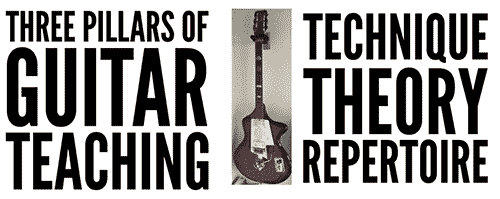
Effective Guitar Pedagogy is built upon three pillars
Developing competence on the guitar can be analysed and divided into acheiving progression over three core areas. If the stuff that you present your students with is at an appropriate level in accordance with the three following areas then there is a pretty good chance that you are most probably "getting it right"
1. Theoretical Knowledge
2. Technical Ability
3. Development of Repertoire
Guitar Pedagogy: Key Concept 1. Theoretical Knowledge
Very important but being as it would seem pretty pointless to know the theory behind all of the music that you can’t yet play this can wait until some capability on the instrument has been achieved. I know that thisapproach flies in the face of some established orthodoxies but this is my page on guitar pedagogy and this is how I do it.
Guitar Pedagogy Key Concept 2. Technical Ability
This involves the guitar student in the development of motor skills and requires the learner to make and refine particular physical movements with relation to the guitar
Guitar Pedagogy Key Concept 3. Repertoire
This involves the development of motor skills and involves the student in making and refining particular physical movements with relation to the guitar
The more switched on reader of this page might have noticed that two of the above definitions are the same and the real eggheads might have worked out that if there were a system of combining a sound technical approach to the guitar with the development of a repertoire of songs etc. then we could end up “killing two birds with one stone”.
To develop both areas effectively why not teach them simple songs (or fragments of songs) that will combine the development of sound technique with the development of a repertoire off songs, chord progressions and riffs that will make your guitar student feel pretty good about themselves and their development as a player?
Having arrived at a point where we have decided that this is a good idea all we need to do is to identify the right chords and to come up with a bunch of songs or chord sequences that feature those chords? The chords of the CAGED SYSTEM
How To Teach Guitar with "CAGED" Chords
Get your guitar students off to a Flying Start (from the very first lesson)
Using The CAGED SYSTEM of Open Guitar Chords

There exists an established method of teaching and learning guitar called the “Caged System” which when fully developed can be used to master the entire neck of the instrument but which in it's basic form sets out a bunch of open chords generally regarded as being the best and easiest ones for a novice guitar player to cope with and which offer the potential to make rapid progress.
The chord shapes are those of C A Am G E Em D and Dm (hence CAGED-Get it?).
If you were to look at the caged system of guitar playing (and teaching) another way it could just as easily be referred to as the (much less memorable -I must confess) “Whatever you do don’t try to get them to play the F chord system”
Guitar teacher's have to be aware of the areas that a student should not be wasting their time, enthusiasm and effort on in addition to presenting them with suitable things to study and the F chord is very much a case in point.
If you take the time to consider it for a while to attempt to get a student who has little or no experience of holding down a single guitar string on the fingerboard to all of a sudden start to clamp down two strings with a single finger is really pretty cruel and unrealistic It is possible to end up with a situation where an up till now perfectly well motivated and potentially capable guitar student becomes convinced that they will never be able to play the instrument
Unfortunately, it is this very situation that loads of traditional printed guitar tuition material uses as a starting point.
Because the key of C has no #s or b’s it is certainly the easiest key to understand theory wise but its guitar chords (or rather the F chord which is a a very important chord in the key) is just about impossible for an novice guitar player to form.
To be aware of the danger of introducing the dreaded F chord (and others like it) at too early a stage is important to anyone setting out to teach guitar. There are not many things guaranteed to dampen the enthusiasm of a novice than being presented with an (apparently simple) challenge that they find way too difficult.
How To Teach Guitar
A tip to help you to "identify" with your customer
If you would like to take a trip back in musical time and remember just how it was like to be a complete novice on the guitar just flip it? If you are right handed then simply fret (rather than strum) with your right hand and strum (rather than fret) with your left. Take a little time attempting to play some of your favourite simple music. It is a great way to develop an understanding what your customer is experiencing. I often do this during a lesson to reassure students that I know what it is like to be in their position. Strange as it may seem guitar students often get embarrased by the fact that they might not yet be too good on the instrument (although that is the whole point of them being in a lesson in the first place)? letting them see the teacher "fail" like this can go a long way towards helping them to feel better about the whole thing?
The first couple of months of a novice guitarist’s career could (and probably should?) be largely taken up with becoming firstly aware of, and then familiar with the chords that make up the caged system. Some of the CAGED chords work particularly well in the key of G and by becoming familiar with just four of them (G Em C and D) a student can develop an extensive and varied repertoire of stuff to practice and play.
The Caged guitar chords give you access to quite literally hundreds of thousands (and possibly even millions - I never really got around to counting them!) of songs (or recognisable fragments of songs) and they can be used to form the building blocks of a sound technical and theoretical approach to teaching and learning the guitar
We also offer a range of Guitar Backing Tracks and Handouts that you can distribute to your students for those teachers who like to work that way
By employing the Caged Guitar system alongside a gradual introduction to single string riffs, patterns and scales you can create the beginnings of a well-rounded guitar player and the start of a successful new business into the bargain?
This article (by Rob Hylton of teachwombat.com is an extended version of an article published on Ultimate guitar.com
The article gained a five star rating among the readers and has an approval rating of 9.3 (on a ten point scale) If you would like to read that article (along with some insightful and relevant comments by the many ultimate Guitar.com visitors who reviewed it) just go to ultimate guitar-columns and enter the search term "teach guitar"
Our materials also concern themselves with the "less glamorous" areas of a guitar teaching business such as how guitar teachers might develop a useable appointments and accounting system Of course we are trying to sell you something but (unfortunately for us) Guitar teachers don't need to buy our stuff to work out how to do the job! What they need are an idea of what the job is (it isn't really about being a world class guitar player) and then they need a simple and convenient way to collect together the resources required to carry out the job? If they can remember what it was like to learn to play guitar they are half way towards understanding how to teach it? Too many teachers spend their time impressing (but also demoralising?) guitar students with their "blinding technique" when what is really required is for the learner to become convinced that there is a clear pathway to becoming a better guitarist (or a guitarist at all?).If you are wondering if you have the "chops" to be a guitar teacher then you might like our page entitled "How good do you need to be to teach guitar?" Please tour this site? Download the freebies and use them with our blessing. How to teach Guitar?.......... Just get some guitar teaching resources and a plan (we can help with that!) and then just do it(that part is up to you)?
The Guitar Teacher's Toolkit

100 printable sheets covering Open Chords-Bar Chords-Scales- Modes- Blank Fretboard and Chord Grids Teaching Diary and Business Card Designs
The Backing Tracks and Handouts Package

20 Backing Tracks and 46 Handouts. An invaluable aid designed to help you to teach both rhythm and lead guitar." If they can't play in time then they can't play?"
The Kids Guitar Teaching Resources

A whole load of resources especially prepared for younger guitar students. Some of the materials feature one finger chords to get kids off to a flying start on guitar
Plus 100 Giant (letter sized) Chord Grids

laminate them in order to help you to teach group guitar lessons, distribute them to your students or just stick on your teaching studio wall? The "Coolest Wallpaper on the planet?"
The Bass Teacher's Toolkit

A freebie featuring Over 60 Bass teaching Handouts covering Scales, Chords, Fingering Exercises etc
Over 300 Sheets to Download and use TODAY!
but maybe you would like to tour the site but in the meantime you could always tell your friends about us?


